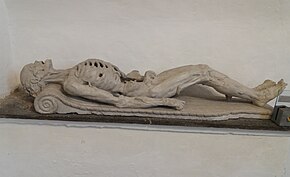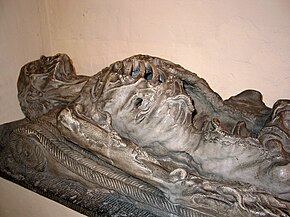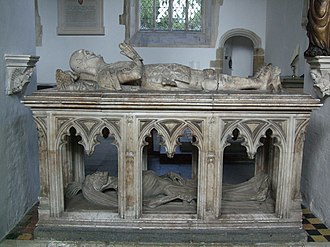20:
464:
43:
238:
141:) of a living person, where they may be life-sized and sometimes represented kneeling in prayer, and in dramatic contrast as a rotting cadaver on the bottom level, often shrouded and sometimes in company of worms and other flesh-eating creatures. The iconography is regionally distinct: the depiction of such animals on these cadavers is more commonly found on the European mainland, and especially in the German regions. The dissemination of cadaver imagery in the late-medieval
104:
160:
492:
in
Kinsale. A variant is in the form of Cadaver Stones, which lack any sculpted superstructure or canopy. These may merely be sculptural elements removed from more elaborate now lost monuments, as is the case with the stone of Sir Edmond Goldyng and his wife Elizabeth Fleming, which in the early part
454:
survive in
Germany and the Netherlands. An impressive example is the 16th-century Van Brederode double-decker monument at Vianen near Utrecht, which depicts Reynoud van Brederode (d. 1556) and his wife Philippote van der Marck (d. 1537) as shrouded figures on the upper level, with a single verminous
94:
Over the centuries, the depictions became more realistic and gruesome, while earlier tendencies to line the tombs with moralizing inscriptions on the vanities of life were abandoned. The morbid art form reached its peak in the late 16th century, with more extreme effigies depicting putrefied corpses
203:
Cadaver monuments were made only for high-ranking persons, usually royalty, bishops, abbots or nobility, because one had to be wealthy to have one made, and influential enough to be allotted space for one in a church of limited capacity. Some monuments for royalty were double tombs, for both a king
152:, cadaver monuments were a dramatic departure from the usual practice of depicting the deceased as they were in life, for example recumbent but with hands together in prayer, or even as dynamic military figures drawing their swords, such as the 13th- and 14th-century effigies surviving in the
268:(died 1402) in Avignon. Kathleen Cohen lists many further extant examples. A revival of the form occurred in the Renaissance, as testified by the two examples to Louis XII and his wife Anne of Brittany at Saint-Denis, and of Queen
90:
or adaption of the motif of "The Three Living and the Three Dead". They show the human body's "transition" from life to decomposition, highlighting the contrast between worldly riches and elegance and the degradation of death.
255:
France has a long history of cadaver monuments, though not as many examples or varieties survive as in
England. One of the earliest and anatomically convincing examples is the gaunt cadaver effigy of the medieval physician
483:
in 1969. One of the best known examples of this tradition is the monumental limestone slab known as "The Modest Man", dedicated to Thomas Ronan (d. 1554), and his wife
Johanna Tyrry (d. 1569), now situated in the
125:. However, the term "cadaver monument" can really be applied to other varieties of monuments, e.g. with skeletons or with the deceased completely wrapped in a shroud. In the "double-decker" monuments, in
183:
is intended as a didactic example of how transient earthly glory is, since it depicts what all people of every status finally become. Kathleen Cohen's study of five French ecclesiastics who commissioned
75:
when they were designed to remind viewers of the transience and vanity of mortal life, and the eternity and desirability of the
Christian after-life. The format is in stark contrast to
82:
Cadaver monuments first appeared in the 1380s and remained a popular form of funerary art for 200 subsequent years. In a still widely debated theory popularized by the historians
673:
188:
monuments determined that common to all of them was a successful worldliness that seemed almost to demand a shocking display of transient mortality. A classic example is the "
789:
Pamela King examines the phenomenon of
English cadaver tombs in her essay "The cadaver tomb in the late fifteenth century: some indications of a Lancastrian connection", in
19:
494:
955:
630:
Oosterwijk, Sophie (2005). "Food for worms – food for thought. The appearance and interpretation of the 'verminous' cadaver in
Britain and Europe".
598:
Oosterwijk, Sophie (2005). "Food for worms – food for thought. The appearance and interpretation of the 'verminous' cadaver in
Britain and Europe".
937:
Welch, Christina. "For
Prayers and Pedagogy: Contextualising English Carved Cadaver Monuments of the Late-Medieval Social and Religious Elite".
876:
918:
46:
463:
367:. The monument, with vermin crawling on a sculpted skeletal corpse, may have been prepared for him, but his body was in fact buried at
179:
The term can also be used for a monument which shows only the cadaver without a corresponding representation of the living person. The
164:
42:
241:
189:
776:
The
Brightwell Baldwin slab is discussed by Sally Badham in her essay "Monumental brasses and the Black Death – a reappraisal',
216:
were doubly portrayed, as couples both as living effigies and as naked cadavers, in their double double-decker monuments in the
965:
360:
237:
970:
71:
of a skeleton, or of an emaciated or decomposing dead body, with closed eyes. It was particularly characteristic of the
513:
720:
340:
of Precentor Sylke, inscribed in Latin: "I am what you will be, and I was what you are. Pray for me I beseech you."
435:
411:
407:
329:
313:
431:
317:
269:
217:
881:
Bass, Marisa Anne. "The transi tomb and the genius of sixteenth century Netherlandish funerary sculpture".
288:
monument is the very faint matrix (i.e. indent) of a now lost monumental brass shrouded demi-effigy on the
415:
379:
149:
975:
960:
383:
257:
695:
489:
419:
364:
341:
321:
79:, which are always recumbent, in full dress, with open eyes and hands clasped and raised in prayer.
485:
418:
in Santa Maria in Ara Coeli and those of Bishop Gonsalvi (1298) and of Cardinal Gonsalvo (1299) in
399:
209:
928:
886:
831:
293:
273:
213:
374:
A rarer, modern type is the standing, shrouded effigy type exemplified by the tomb of the poet
914:
872:
423:
309:
265:
651:"'For no man mai fro dethes stroke fle'. Death and Danse Macabre iconography in memorial art"
95:
outside of the funerary monument context, and taking centre stage as stand-alone sculptures.
528:
Metamorphosis of a Death Symbol: The Transi Tomb in the Late Middle Ages and the Renaissance
356:
345:
333:
221:
134:
72:
753:
475:
A total of 11 cadaver monuments have been recorded in Ireland, many of which are no longer
674:"A Portrait of Death: Analyzing the Transi Tomb of Guillaume de Harcigny (1300–1393 A.D.)"
439:
35:
897:
A Portrait of Death: Analyzing the Transi Tomb of Guillaume de Harcigny (1300–1393 A.D.)
825:
906:
403:
337:
325:
249:
193:
168:
126:
949:
896:
451:
395:
305:
264:. Another early example is the effigy on the multi-layered wall-monument of Cardinal
220:
near Paris. Other varieties also exist, such as cadaver imagery on incised slabs and
153:
142:
911:
Tomb Sculpture: Four Lectures on its Changing Aspects from Ancient Egypt to Bernini
821:
488:
in Cork. This is one of two examples recorded in Cork, with the second residing in
480:
352:
289:
87:
83:
64:
791:
Dies Illa: Death in the Middle Ages: Proceedings of the 1983 Manchester Colloquium
300:
effigy made its appearance in England. Cadaver monuments survive in many English
368:
172:
156:, London. Cadaver monuments often acted as a portrait of the deceased in death.
68:
23:
107:"L'homme aux moulons" (man eaten by worms), a 16th-century cadaver monument in
382:
in London. Similar examples from the Early Modern period signify faith in the
375:
245:
224:, including the so-called "shroud brasses", of which many survive in England.
197:
802:
Jean Wilson, "Go for Baroque: The Bruce Mausoleum at Maulden, Bedfordshire",
301:
205:
180:
27:
728:
292:
slab commemorating "John the Smith" (c.1370) at St Bartholomew’s Church in
103:
468:
116:
932:
890:
476:
427:
86:
and John Aberth, cadaver monuments are often interpreted as a form of
108:
76:
31:
869:
Revisiting The Monument: Fifty Years since Panofsky’s Tomb Sculpture
159:
650:
479:. The earliest complete record of these monuments was compiled by
462:
236:
158:
102:
41:
18:
830:. London: Sampson Low, Marston, Searle, and Rivington. pp.
261:
130:
414:
in Rome. Three other prominent monuments are those of Cardinal
145:
may also have influenced the iconography of cadaver monuments.
696:"Restauration du 'Squelette' de Ligier Richier à Bar-le-Duc"
493:
of the 16th century was built into the churchyard wall of
827:
Ghiberti and Donatello with Other Early Italian Sculptors
351:
The cadaver monument traditionally identified as that of
115:
A depiction of a rotting cadaver in art (as opposed to a
923:
Roe, Helen M. "Cadaver Effigial Monuments in Ireland".
516:. Church Monument Society, 2010. Retrieved 25 June 2023
925:
Journal of the Royal Society of Antiquaries of Ireland
681:
The Coalition of Master's Scholars on Material Culture
398:
sculpted several of them, including those of Cardinal
394:
Cadaver monuments are found in many Italian churches.
467:
Cadaver stone of Sir Edmond Goldyng and his wife, in
355:, Abbot of Tewkesbury from 1531 to 1539, survives in
272:
who commissioned a cadaver monument for her husband
514:
Cadaver Monument of Guillaume de Harcigny (D. 1393)
901:Coalition of Master’s Scholars on Material Culture
754:"Monument of the month – Church Monuments Society"
296:in Oxfordshire. In the 15th century the sculpted
49:. Musée d'art et d'archéologie de Laon, France
816:
814:
812:
16:Effigy tombs or slabs depicting decomposition
8:
871:. London: Courtauld Institute of Art, 2016.
883:Netherlands Yearbook for the History of Art
530:. Berkeley: University of California Press.
67:to a deceased person, featuring a sculpted
324:houses the well-known cadaver monument to
721:"Picture Library – Shrouds and Skeletons"
363:, he retired and later became the first
748:
746:
506:
495:St. Peter's Church of Ireland, Drogheda
336:survives the 16th-century monument and
548:
546:
47:Cadaver Tomb of Guillaume de Harsigny
7:
196:, in the church of Saint Etienne in
308:. The earliest surviving one is in
672:Heimerman, Emily (April 2, 2021).
242:Cadaver monument of René de Chalon
165:John Fitzalan, 7th Earl of Arundel
14:
927:, volume 99, No. 1, 1969. p. 4.
410:and Bishop Juan Díaz de Coca in
406:, Ludovico Cardinal d'Albert at
200:, France, pictured below right.
956:Burial monuments and structures
913:. London: Harry Abrams, 1964.
361:dissolution of the monasteries
167:(died 1435), Fitzalan Chapel,
133:displays on the top level the
1:
204:and queen. The French kings
129:'s phrase, a sculpted stone
649:Oosterwijk, Sophie (2008).
450:Many cadaver monuments and
446:Germany and the Netherlands
344:has two cadaver monuments.
992:
941:, Equinox Publishing, 2012
758:churchmonumentssociety.org
700:Le Journal du Conservateur
694:Janvier, François (2004).
378:(d. 1631) in the crypt of
436:tomb of Pope Innocent III
412:Santa Maria sopra Minerva
244:, Church of St. Étienne,
190:Transi de René de Chalons
793:, Jane H. M. Taylor, ed.
526:Cohen, Kathleen (1973).
408:Santa Maria in Ara Coeli
330:Archbishop of Canterbury
318:Lincoln College, Oxford
218:Basilica of Saint-Denis
570:Heimerman (2021), p. 7
561:Heimerman (2021), p. 3
472:
426:, the youngest of the
252:
176:
150:Christian funerary art
112:
50:
39:
966:Christian iconography
939:Fieldwork in Religion
780:, 80 (2000), 225–226.
725:www.mbs-brasses.co.uk
466:
434:in Rome contains the
258:Guillaume de Harsigny
240:
162:
106:
45:
22:
971:History of sculpture
579:Cohen (1974), p. 179
490:Church of St Multose
486:Triskel Christchurch
420:Santa Maria Maggiore
416:Matteo d'Acquasparta
371:in Gloucestershire.
365:Bishop of Gloucester
342:Winchester Cathedral
322:Canterbury Cathedral
270:Catherine de' Medici
163:Cadaver monument of
895:Heimerman, Emily. "
885:, volume 67, 2017.
844:Roe (1969), pp. 1–3
806:, 22 (2007), 66–95.
778:Antiquaries Journal
620:(New York) 1964:65.
588:Bass (2017), p. 163
552:Covi (1975), p. 385
432:St Peter’s Basilica
380:St Paul's Cathedral
332:(died 1443) and in
284:The earliest known
877:978-1-9074-850-6-0
540:Cohen (1974), p. 9
473:
422:, all sculpted by
320:and died in 1431.
294:Brightwell Baldwin
253:
222:monumental brasses
177:
113:
51:
40:
919:978-0-8109-3870-0
867:Barker, Jessica.
638:: 40–80, 133–140.
424:Giovanni de Cosma
310:Lincoln Cathedral
266:Jean de La Grange
65:funerary monument
983:
854:
853:Roe (1969), p. 4
851:
845:
842:
836:
835:
818:
807:
804:Church Monuments
800:
794:
787:
781:
774:
768:
767:
765:
764:
750:
741:
740:
738:
736:
727:. Archived from
717:
711:
710:
708:
706:
691:
685:
684:
678:
669:
663:
662:
661:: 62–87, 166–68.
655:Church Monuments
646:
640:
639:
632:Church Monuments
627:
621:
614:
608:
607:
600:Church Monuments
595:
589:
586:
580:
577:
571:
568:
562:
559:
553:
550:
541:
538:
532:
531:
523:
517:
511:
430:family lineage.
400:Alain de Coëtivy
359:. Following the
357:Tewkesbury Abbey
348:has an example.
346:Exeter Cathedral
334:Exeter Cathedral
135:recumbent effigy
73:Late Middle Ages
55:cadaver monument
30:of the Lords of
991:
990:
986:
985:
984:
982:
981:
980:
946:
945:
944:
907:Panofsky, Erwin
903:, April 2, 2021
863:
858:
857:
852:
848:
843:
839:
820:
819:
810:
801:
797:
788:
784:
775:
771:
762:
760:
752:
751:
744:
734:
732:
731:on 4 March 2016
719:
718:
714:
704:
702:
693:
692:
688:
676:
671:
670:
666:
648:
647:
643:
629:
628:
624:
615:
611:
597:
596:
592:
587:
583:
578:
574:
569:
565:
560:
556:
551:
544:
539:
535:
525:
524:
520:
512:
508:
503:
461:
455:cadaver below.
448:
440:Giovanni Pisano
392:
314:Richard Fleming
306:parish churches
282:
235:
230:
101:
17:
12:
11:
5:
989:
987:
979:
978:
973:
968:
963:
958:
948:
947:
943:
942:
935:
921:
904:
893:
879:
864:
862:
859:
856:
855:
846:
837:
808:
795:
782:
769:
742:
712:
686:
664:
641:
622:
618:Tomb Sculpture
609:
606:: 63, 133–140.
590:
581:
572:
563:
554:
542:
533:
518:
505:
504:
502:
499:
460:
457:
447:
444:
438:, sculpted by
404:Santa Prassede
391:
388:
338:chantry chapel
326:Henry Chichele
281:
278:
250:Ligier Richier
234:
231:
229:
226:
194:Ligier Richier
169:Arundel Castle
127:Erwin Panofsky
119:) is called a
100:
97:
15:
13:
10:
9:
6:
4:
3:
2:
988:
977:
974:
972:
969:
967:
964:
962:
959:
957:
954:
953:
951:
940:
936:
934:
930:
926:
922:
920:
916:
912:
908:
905:
902:
898:
894:
892:
888:
884:
880:
878:
874:
870:
866:
865:
860:
850:
847:
841:
838:
833:
829:
828:
823:
822:Scott, Leader
817:
815:
813:
809:
805:
799:
796:
792:
786:
783:
779:
773:
770:
759:
755:
749:
747:
743:
730:
726:
722:
716:
713:
701:
697:
690:
687:
682:
675:
668:
665:
660:
656:
652:
645:
642:
637:
633:
626:
623:
619:
613:
610:
605:
601:
594:
591:
585:
582:
576:
573:
567:
564:
558:
555:
549:
547:
543:
537:
534:
529:
522:
519:
515:
510:
507:
500:
498:
496:
491:
487:
482:
478:
470:
465:
458:
456:
453:
452:ledger stones
445:
443:
441:
437:
433:
429:
425:
421:
417:
413:
409:
405:
401:
397:
396:Andrea Bregno
389:
387:
385:
381:
377:
372:
370:
366:
362:
358:
354:
349:
347:
343:
339:
335:
331:
327:
323:
319:
315:
311:
307:
303:
299:
295:
291:
287:
279:
277:
275:
271:
267:
263:
260:(d. 1393) at
259:
251:
248:, France, by
247:
243:
239:
232:
227:
225:
223:
219:
215:
211:
207:
201:
199:
195:
191:
187:
182:
174:
170:
166:
161:
157:
155:
154:Temple Church
151:
146:
144:
143:danse macabre
140:
136:
132:
128:
124:
123:
118:
110:
105:
98:
96:
92:
89:
85:
80:
78:
74:
70:
66:
63:is a type of
62:
61:
56:
48:
44:
37:
36:Boussu Castle
33:
29:
25:
21:
976:Memento mori
961:Cadaver tomb
938:
924:
910:
900:
882:
868:
849:
840:
826:
803:
798:
790:
785:
777:
772:
761:. Retrieved
757:
733:. Retrieved
729:the original
724:
715:
703:. Retrieved
699:
689:
680:
667:
658:
654:
644:
635:
631:
625:
617:
612:
603:
599:
593:
584:
575:
566:
557:
536:
527:
521:
509:
481:Helen M. Roe
474:
449:
393:
384:Resurrection
373:
353:John Wakeman
350:
316:who founded
312:, to Bishop
297:
290:ledger stone
285:
283:
254:
202:
185:
178:
147:
138:
121:
120:
114:
93:
88:memento mori
84:Helen M. Roe
81:
59:
58:
54:
52:
369:Forthampton
173:West Sussex
69:tomb effigy
24:Tomb effigy
950:Categories
763:2020-10-17
616:Panofsky,
501:References
376:John Donne
302:cathedrals
246:Bar-le-Duc
198:Bar-le-Duc
705:24 August
471:, Ireland
228:Countries
210:Francis I
206:Louis XII
181:sculpture
175:, England
111:, Belgium
38:, Belgium
28:mausoleum
933:25509699
891:26593102
824:(1882).
735:20 April
469:Drogheda
274:Henry II
214:Henry II
117:skeleton
99:Overview
861:Sources
477:in situ
459:Ireland
428:Cosmati
280:England
77:gisants
26:in the
931:
917:
889:
875:
298:transi
286:transi
233:France
186:transi
139:gisant
122:transi
109:Boussu
60:transi
32:Boussu
929:JSTOR
887:JSTOR
677:(PDF)
390:Italy
192:" by
915:ISBN
873:ISBN
834:–50.
737:2012
707:2019
304:and
262:Laon
212:and
137:(or
131:bier
899:".
402:in
148:In
57:or
952::
909:.
832:27
811:^
756:.
745:^
723:.
698:.
679:.
659:23
657:.
653:.
636:20
634:.
604:20
602:.
545:^
497:.
442:.
386:.
328:,
276:.
208:,
171:,
53:A
34:,
766:.
739:.
709:.
683:.
Text is available under the Creative Commons Attribution-ShareAlike License. Additional terms may apply.



